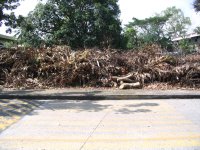 Ray was back in the Philippines for a business trip and had an opportunity to see first hand some of the damage and the power of the typhoon that went through the Philippines in late September.
Ray was back in the Philippines for a business trip and had an opportunity to see first hand some of the damage and the power of the typhoon that went through the Philippines in late September.The coconut trees at the Philippine Plaza along Manila Bay were upright now, but it appeared that many had been knocked over during the typhoon. Many were also topped off and now just stand like telephone poles out in the garden. The pool was being repaired, and I don't know how
 much of that was due to storm damage as the hotel is going through a general renovation.
much of that was due to storm damage as the hotel is going through a general renovation.Heading south out of Manila, he could see the downed and stripped trees all along the expressway. Many piles of debris had been piled up alongside the road. The South Expressway had been totally blocked by fallen trees and debris during and after the storm. Clearing the road has been the first priority, with pickup of the debris coming later.
 The Sta. Elena golf course was hard hit by the typhoon. Although very playable at this point since the greens, tees and fairways suffered little actual damage, the vegetation around the perimeter of the holes was severely damaged. Every hole is surrounded by trees and plants, and they took the brunt of the storm.
The Sta. Elena golf course was hard hit by the typhoon. Although very playable at this point since the greens, tees and fairways suffered little actual damage, the vegetation around the perimeter of the holes was severely damaged. Every hole is surrounded by trees and plants, and they took the brunt of the storm. Some large trees were snapped off anywhere from 10-20 feet above the ground, others were toppled roots and all. For as large as the trees were, their root systems were very shallow. Even the trees that remain standing were relatively bare as their leaves were stripped off.
Some large trees were snapped off anywhere from 10-20 feet above the ground, others were toppled roots and all. For as large as the trees were, their root systems were very shallow. Even the trees that remain standing were relatively bare as their leaves were stripped off.A lot of the trees that were down have been uprighted, although many are still laying down. Even some of the snapped off trees have been uprighted and will begin to leaf out again and grow from the point they were broken.
 A deep (50-75 feet) ravine with a usually small creek runs through the course. The creek walls have been covered in grasses and other vegetation in the past. They are now bare, down to the soil, rock, or concrete applied to prevent erosion. It has really changed the look of the creek and some of the holes. The amount of water that was flowing through that creek bed was tremendous, based on the damage and new look of the creek. It appears that the level of the water was over halfway up the banks.
A deep (50-75 feet) ravine with a usually small creek runs through the course. The creek walls have been covered in grasses and other vegetation in the past. They are now bare, down to the soil, rock, or concrete applied to prevent erosion. It has really changed the look of the creek and some of the holes. The amount of water that was flowing through that creek bed was tremendous, based on the damage and new look of the creek. It appears that the level of the water was over halfway up the banks. One of the most affected holes in my opinion was number 8. This was double dog-leg that followed around the creek. You could cut the first corner over the trees, but could not see the fairway where you wanted to land. Due to the lost trees and loss of leaves on the trees that did remain, you can now see the landing areas from the tee. The creek now has no vegetation coverage from tee to green. The look of the hole has totally changed.
One of the most affected holes in my opinion was number 8. This was double dog-leg that followed around the creek. You could cut the first corner over the trees, but could not see the fairway where you wanted to land. Due to the lost trees and loss of leaves on the trees that did remain, you can now see the landing areas from the tee. The creek now has no vegetation coverage from tee to green. The look of the hole has totally changed.There has been a lot of work done on the course, but there is a lot of work to be done. Only time will allow the trees to come back and give the course the look and feel it once had.
At Club Intramuros Golf Course in Manila itself, most of the trees survived, but some of the light fixtures were toppled, making some dark areas for the night golfing. The protection offerred by the buildings surrounding Club Intramuros was evident comparing the damage in the inner city vs that in the rural area
 On the southern edge of Manila in Alabang, there was signifcant damage to trees and vegetation, but not as much as further south towards Calamba. Some trees were uprooted and toppled, but not as many appeared to be topped off. The village had been collecting brush and piling it in various empty lots, and some of the brush piles grew quite large. Many of the large toppled trees have already been cut down to the stump, so they don't stick out as much as the toppled trees that remain whole in other areas.
On the southern edge of Manila in Alabang, there was signifcant damage to trees and vegetation, but not as much as further south towards Calamba. Some trees were uprooted and toppled, but not as many appeared to be topped off. The village had been collecting brush and piling it in various empty lots, and some of the brush piles grew quite large. Many of the large toppled trees have already been cut down to the stump, so they don't stick out as much as the toppled trees that remain whole in other areas. There will be a lot of time required for this area to fully heal and recover, but a lot of progress has already been made. One of the local houses that always puts up a large Holloween decoration carried through with the tradition again this year
There will be a lot of time required for this area to fully heal and recover, but a lot of progress has already been made. One of the local houses that always puts up a large Holloween decoration carried through with the tradition again this year
No comments:
Post a Comment